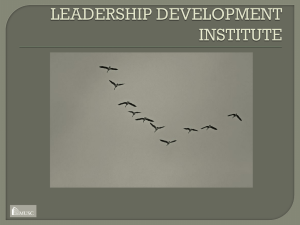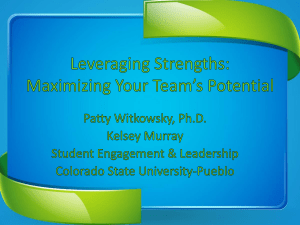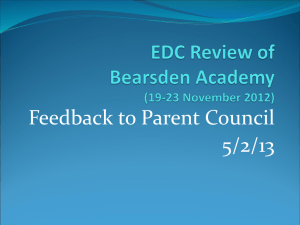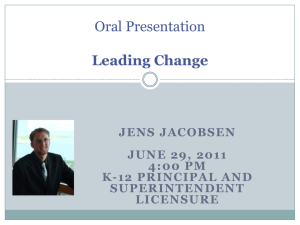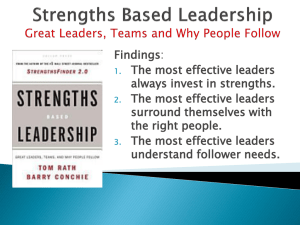Presentation Materials
advertisement
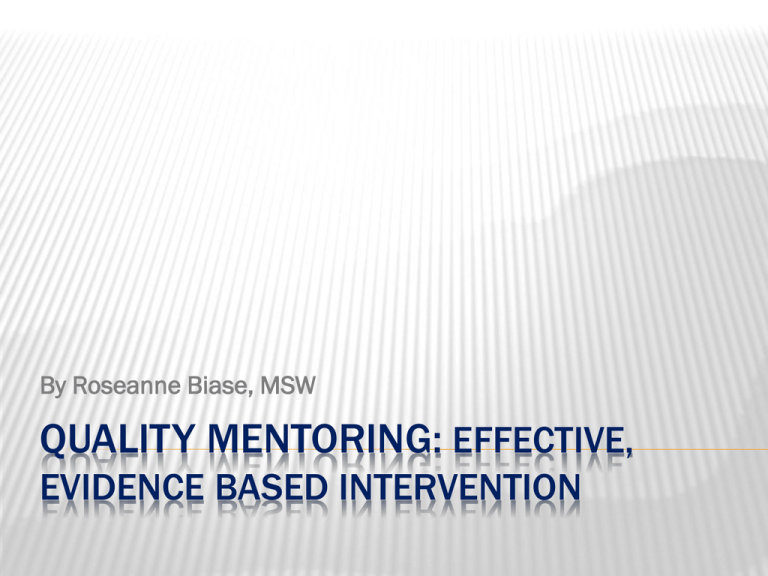
By Roseanne Biase, MSW QUALITY MENTORING: EFFECTIVE, EVIDENCE BASED INTERVENTION THE AGENDA Introduction Learning objectives Defining at-risk youth Empirical evidence supporting the strengths based approach Customizing appropriate intervention for youth Developing altruism in youth – empirical evidence Summary INTRODUCTION Roseanne Biase, MSW Obtained MSW at Virginia Commonwealth University Certified in Gender Violence Intervention at VCU Director of 360° Therapeutic Mentor/Life Skills Coach Program Married 25 yrs. & have 3 children: one just graduated from GMU, one is at ODU, and the other is at ECU AT RISK YOUTH Defining factors of the population at various levels – Interactive exercise Individual/student Family School Community DEFINING FACTORS Individual/ Student level Poor school/general attitude Low ability level Attendance/Truancy Behavior/discipline problems Pregnancy Drug abuse Poor peer relationships Nonparticipation Friends have dropped out Illness/disability Low self-esteem/self-efficacy DEFINING FACTORS Family Level Low socioeconomic status Dysfunctional home life No parent involvement Low parental expectations Non-English speaking home Ineffective parenting/abuse High mobility DEFINING FACTORS School level Conflict between home/school culture Ineffective discipline system Lack of adequate counseling Negative school climate Lack of relevant curriculum Passive instructional strategies Incorrect use of technology Disregard of student learning styles Retentions/suspensions Low expectations Lack of language instruction DEFINING FACTORS Community Level Lack of community support services Lack of community support for schools High incidences of criminal activities Lack of school/community linkages (Wells, 1990) STRENGTHS AT DIFFERENT LEVELS Everybody – every: individual Family Group Community – has strengths. Find your clients strengths and you find STRENGTHS BASED PERSPECTIVE Using Strengths Perspective: Practicing from a strengths perspective means that everything you do as a helper will be based on facilitating the discovery and embellishment, exploration, and use of clients’ strengths and resources in the service of helping them achieve their goals and realize their dreams. -Dennis Saleebey STRENGTHS BASED PERSPECTIVE You cannot empower any youth by berating shortcomings or failures. Empowerment comes from three things: 1) Valuing oneself 2) Having achievable goals 3) Creating a plan to reach these goals that has the potential to be successful (http://homepages.wmich.edu/~weinreic/SWRK350/TheoryLearningObject/strengths) STRENGTHS BASED PERSPECTIVE The strengths model has been used in helping: Adults with severe and persistent mental illness, People struggling with alcohol and drug abuse, Seriously emotionally disturbed children and their families, Older citizens, children and adults in the justice system, Neighborhoods and communities, It has also been used as a framework for policy analysis. (University of Kansas, School of Social Welfare) STRENGTHS BASED PERSPECTIVE Empirical research on Strengths Based Case Management (SBCM), both quantitative and qualitative, done by the Center for Interventions, Treatment, and Addictions Research (CITAR) found: Improved retention in aftercare services Improved employment functioning Reduction in drug use Reduction in criminal justice involvement (Rapp, Siegal, Li, & Saha, 1998; Siegal et al., 1996; Siegal, Li, & Rapp, 2002). STRENGTHS BASED PERSPECTIVE 1. 2. 3. 4. 5. 6. According to Saint-Jacques, et al. (2009) the strengths-based approach is based on six key principles: Every individual, family, group and community has strengths, and the focus is on these strengths rather than pathology The community is a rich source of resources Interventions are based on youth’s self-determination Collaboration is central with the mentee – mentor relationship as primary and essential Outreach is employed as a preferred mode of intervention All people have the inherent capacity to learn, grow and change. STRENGTHS BASED PERSPECTIVE Let’s review all 6 principles Interactive 1. How do we get past the defining factors of these youth? 2. Name strengths in each domain How is the community rich in resources? 1. Practice using an eco-map so mentee can see his/her resources 1. Draw an example of an eco-map STRENGTHS BASED PERSPECTIVE Continue reviewing all 6 principles Interactive 3. How do we build youth’s self-determination? 1. The Pacer Center for Children describes it best: “Self-determination involves many attitudes and abilities including: self-awareness, assertiveness, creativity, pride, problem solving and self-advocacy skills. To take charge of your own life, you must be able to set goals, evaluate options, make choices and then work to achieve your goals”. (http://www.pacer.org/tatra/resources/self.asp) 4. How do you collaborate with your mentee? See OARS INTERVENTION Remember to use your OARS: Open ended question Affirm Reflective listening Summarize (www.amhd.org) INTERVENTION Continue reviewing all 6 principles 5. Are you participating in outreach projects with your youth? Interactive What kind of meaningful activities have you been involved in with your mentee that has made a difference in the youth’s life? INTERVENTION Promote social justice through action/social interactions Cognitive reconstruction: changing negative thoughts about others to doing positive, meaningful activities for others. Here are some ideas: Youth are more open to helping the vulnerable (youth, elderly, homeless, sometimes the sick) Tutor program – tutoring in elementary schools or the disabled Elderly – nursing homes Meals on wheels Art to donate for a cause, have the youth start a project Starting school projects prom (car reenactment) MTV project (counseling) dating violence month They experience a reward when they know they have made a difference INTERVENTION Utilizing mentees strengths Strengths are properly defined not simply as activities at which people excel, but also as activities that strengthen people and energize them; activities for which they have a strong appetite. -Marcus Buckingham Searching and exploring is part of the journey to finding what gives your mentee their passion. INTERVENTION Interactive What energizes your youth? Look into their gifts and talents Maybe the youth is caring – cares for younger siblings What if your youth was musically inclined Volunteer at a hospital or nursing home Have them take their instrument and volunteer to sing at a pre-school, hospital, at a coffee shop for a fundraiser If they are artistic – photography, painting, graphic design The opportunities are endless – see photo below and let’s discuss ideas INTERVENTION Continue to review all 6 principles 6. Everyone has the capacity to learn grow and change. This is where you can help develop altruistic qualities in your mentee. Empirical evidence supports Altruism develops in people, as opposed to being an inherited trait. (Krebs & Van Hesteren, 1994) DEVELOPING GOODNESS IN YOUTH Human altruism consists of the following altruistic behaviors Helping in times of danger Sharing food Helping the sick, the wounded or the very old and young Sharing implements Sharing knowledge (Trivers,1971 ‘Harvard University’) http://www.emusic.com/listen/#/album/binaural-beat-brainwavesubliminal-systems/developing-altruism/13432399/ DEVELOPING GOODNESS IN YOUTH It’s our responsibility to help the process of starting to develop the goodness in youth! There is potential in every human being! DEVELOPING GOODNESS IN YOUTH Conclusion Strengths should be assessed at various levels Individual, Family, Group, and Community Intervention to develop goodness in youth is a journey to explore a variety of activities in their community Altruistic cognitive development starts by exploring various ideas, talents, and gifts The youth is learning social justice through positive social interactions Altruistic behaviors can be developed and is not genetic At-risk youth live in a world of complications but have a wealth of potential!!! ENDING THOUGHT Everything that is done in the world is done by hope. Martin Luther King, Jr.
